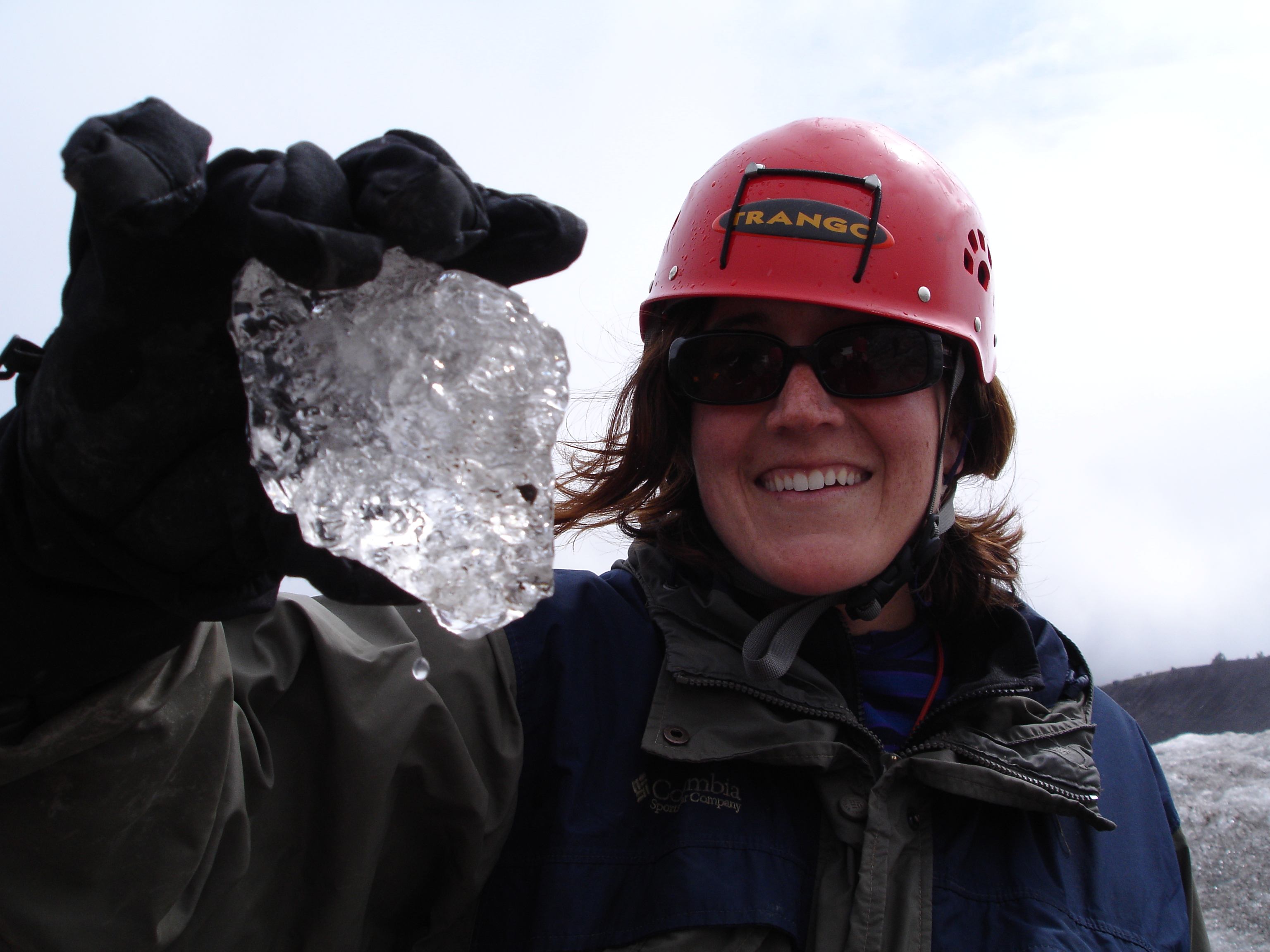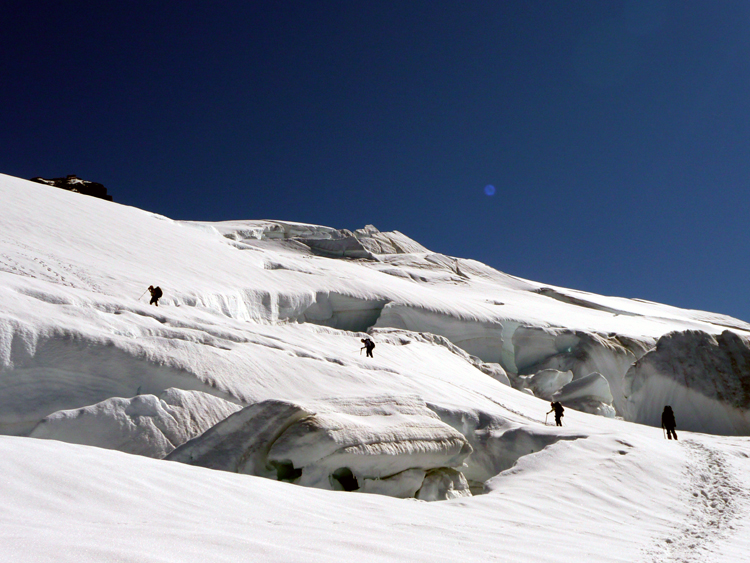
Each year, a new Girls on Ice team spends eight days exploring glaciated Mt. Baker in Washington State guided by myself, mountaineer Cecelia Mortonson, and a third (rotating) instructor. The nine teenage girls on the team learn not only about alpine geology, glaciology, and mountaineering, but they also challenge themselves and gain self-confidence in their physical, intellectual, and social abilities. Girls on Ice is the science version of a "language immersion" experience — where we connect science with all aspects of daily life with the goal of creating lifelong advocates for Earth science, specifically, and the scientific process as a whole, regardless of whether or not they decide to specialize in science in college.
I created Girls on Ice simply because I wanted to share the excitement of field science — the excitement of being surrounded by the natural processes I am studying. For myself (along with many other scientists), fieldwork is a primary inspiration for the research, and I wanted to share this inspiration with younger women who are at a transitional point in their lives. Girls on Ice has grown far beyond my original ideas, however, and has been successful mostly because of the people and organizations that have helped along the way. In particular, the support of the scientific community as a whole has played a role in the program's success.
Girls on Ice today is a result of a close collaboration with the North Cascades Institute (an educational partner to North Cascades National Park). We designed the program with three underlying philosophies in mind: that teaching the whole process gives them ownership of the science; that teaching to the whole student puts the science in context; and that diversity inspires new ideas, new approaches, and better science in the end.
The Whole Process. In school, students often learn the scientific method as a linear process of moving from observation to question to experiment to conclusion. Those of us in science know there is rarely linearity in "real" science: the original question and hypothesis may lead to data, which cause us to rewrite the question and redesign the experiment. If a student is lucky, he or she will have a teacher who will explain the nonlinearity of the scientific process and allow the students to experience it, but this is difficult in the classroom where observations are often limited.
We approach teaching the scientific process in Girls on Ice through encouraging the girls to interact with and explore the alpine setting first, before we tell them the ideas and theories of other scientists (one of the biggest challenges in both teaching and learning science is getting the students to let go of preconceived ideas of what the answer is). As we teach them the basics of glacier travel and safety, we guide them through various activities aimed at getting them to use all of their senses to interact with the environment. For example, this year our rotating instructor was an "expeditionary artist" who taught the girls to see the glacier as various shadings of color and shadows, shapes and boundaries, and textures rather than as a "glacier". The eye of an artist is not that different than the eye of a scientist: both need to be open to seeing something new and different.
Their observations of the landscape lead to questions and discussions and finally to the design of experiments. Every year the experiments are different. In 2008, we had a group of girls study the behavior of ice worms, a group measured the slow glacier change through mass balance techniques, and a group measuring fast glacier changes through time-lapse photography. The girls define hypotheses, collect data, and discuss ideas and conclusions. After coming down off the mountains, they write a description of their project for themselves to take with them and for future Girls on Ice teams.

The Whole Student. It is sometimes too easy to judge an outreach or education program on the number of students it reaches, rather than the impact it has on each student's life. Girls on Ice is intended to be a high-impact program focused on a few students, with the goal of creating life-long science learners and teachers. By showing them how science is integrated into everything they do — from how to pack their backpack to carry weight efficiently to how to interpret the clouds for signs of coming weather — the girls will begin to see science as a part of their life. The integration of art techniques into their learning is an example of teaching to the whole student, especially for those for whom science is still intimidating. We also challenge the girls' thoughts and ideas through evening discussions of the philosophy of science, the role of science in society, how media portrays science, and other questions. Ultimately our goal is to offer girls a tangible connection to both the scientific process and to the natural processes that create the world around us in hopes that in the future they will pass on their experience to others through stories and actions.
Diversity in Science. The creative side of science — how and what questions are asked — benefits from a diversity of viewpoints: the more variety of questions asked, the higher the chance of finding the right questions that will lead to major new discoveries. For this and other reasons, we choose a team of girls (from among 100 or more applicants) who are diverse in all aspects of their personalities. Currently, the program is tuition-free (primarily through private donations) to ensure that girls from all walks of life can participate. The all-girls format (although technically a limitation on our philosophy of diversity) is intended to provide the young girls with a comfortable environment to challenge themselves and discover their own abilities and self-confidence.
Since 1999, over 60 girls have participated in Girls on Ice, many have graduated from college (in fields such as geology, mechanical engineering, environmental science, and many other science fields), and at least one is now pursuing a PhD (in microbiology). Depending on continued (and increased) funding and support, we are considering ways to expand the program.
Ultimately, I hope that this "science immersion" program will continue to influence girls' lives and create life-long advocates for the value of earth science in our society and for minimizing human impact on the earth.
For more information about the Girls on Ice program, contact:
- Erin Pettit, Girls on Ice Instructor, at pettit@gi.alaska.edu
- Megan McGinty, Girls on Ice Program Coordinator, at megan_mcginty@ncascades.org or (360) 856-5700 ext. 202
- Or visit the Girls on Ice website at: http://girlsonice.org/
